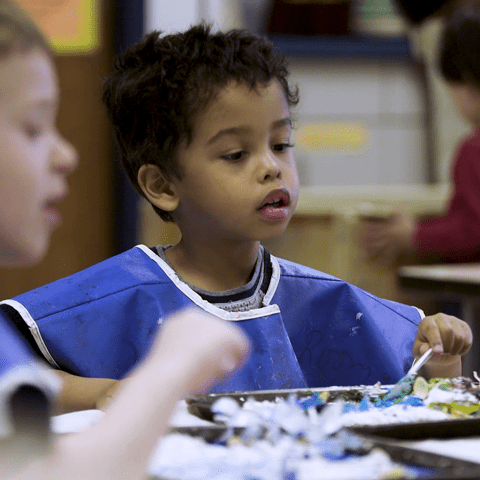About this video
Children demonstrate their curiosity in science by observing, asking questions, describing events, and investigating. Teachers can help children develop their science skills by helping them design and implement investigations, modeling scientific language, and describing experiences.
In this video, we watch several students conduct an experiment with glue, food coloring, and water. The teacher encourages the children to actively explore the materials, think about what is happening, and describe the experience. The children use their communication and social skills to engage in conversation and express their wants appropriately.
Video
Transcript
Teacher: Oooh. Look at you. That is awesome.
Anyone want some more water in their glue plates?
Child: I want some.
Child 2: I want some more.
Teacher: Okay, let’s see what happens.
This is like a big experiment. We don’t know what’s going to happen.
When all those colors mix.
Child: I want to touch it with my finger.
Teacher: Here you go, sir.
Oh my gosh, that looks kind of swampy right there.
This looks like I’m at the beach.
Child: Oohh. It’s a beach.
Child 2: Like a beach. Like sharks.
Benchmarks and How They Were Met
| Benchmarks | How They Were Met |
|---|---|
| Language Arts 1.B.ECa: Use language for a variety of purposes. 1.B.ECb: With teacher assistance, participate in collaborative conversations with diverse partners (e.g., peers and adults in both small and large groups) about age-appropriate topics and texts. 1.B.ECc: Continue a conversation through two or more exchanges. | The children engage in a short conversation that is led by the teacher but incorporates several partners. This helps them learn how to have collaborative conversations with a variety of people. They also use language to describe, answer questions, and make requests. |
| Science 11.A.ECa: Express wonder and curiosity about their world by asking questions, solving problems, and designing things. 11.A.ECc: Plan and carry out simple investigations. 11.A.ECf: Make meaning from experience and information by describing, talking, and thinking about what happened during an investigation. | The children carry out an “experiment” by mixing glue, food coloring, and water. The teacher encourages the children to think about what is happening on their trays. She uses words to describe what is happening during their experiment. She describes the materials as they are being mixed. She uses words such as swampy and like a beach. The children also talk about the materials and show their curiosity by touching it with their fingers and adding more water to their work. |
| Social/Emotional Development 30.A.ECb: Use appropriate communication skills when expressing needs, wants, and feelings. 30.A.ECe: Use materials with purpose, safety, and respect. | The children show their ability to self-manage their behaviors. For example, the children politely express they want more water. They also wait patiently while the teacher passes it out. In addition, the children use their materials purposefully and safely while respecting others. They keep their materials on their trays and use their paintbrushes and other tools to do their project. |


